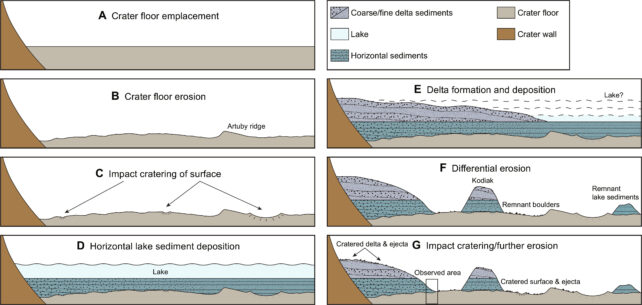ARTICLE AD
If signs of life really do exist on Mars, there's a chance the Perseverance rover has already rolled over them.
Underground radar images suggest it is searching in the perfect spot for fossilized microbial life.
As the robotic explorer, nicknamed Percy, wheels across a three-billion-year-old landscape, its instruments have confirmed that at least one Martian crater was filled with water long ago.
Scientists strongly suspected the Jezero Crater once contained a delta system, as its surface holds the telltale signs of a dried-out lake bed, fed by an ancient river. That's why a Mars rover was sent to investigate the crater in February of 2021.
Now that researchers can peer beneath Jezero's dusty exterior, they are more excited than ever by the possibility that Percy has already scooped up signs of extraterrestrial life.
"From orbit we can see a bunch of different deposits, but we can't tell for sure if what we're seeing is their original state, or if we're seeing the conclusion of a long geological story," explains planetary scientist and first author David Paige from the University of California Los Angeles (UCLA).
"To tell how these things formed, we need to see below the surface."
Of all seven tools on board Perseverance, the ground-penetrating radar, called RIMFAX for short, is perhaps its greatest superpower.
This system has the ability to detect ice, water, or salty brines more than 10 meters (30 feet) below the dusty surface, and it can map layers of soil and rock down to 20 meters.
frameborder="0″ allow="accelerometer; autoplay; clipboard-write; encrypted-media; gyroscope; picture-in-picture; web-share" allowfullscreen>
For a good chunk of last year, Perseverance was trundling along the western edge of the Jezero crater, and it was using its radar to probe the surface below.
The data it collected have now provided an unprecedented glimpse below the Martian surface, in the very place where scientists suspect a lake to have been.
Underground imaging now strongly suggests that hunch was right. Beneath the suspected delta, an international team of researchers found evidence that the 4-billion-year old crater, made by an asteroid impact, was later filled with younger sediment and rocks.
The findings support previous RIMFAX data from a separate location, which revealed unexpected slopes in sediment layers deposited in the crater.
These younger sediments could have been carried into the crater via water or volcanic activity, but the new radar data from Percy, suggests the former hypothesis is more likely.
 Diagram of the depositional and erosional history of the Jezero western delta region. (Paige et al., Science Advances, 2024)
Diagram of the depositional and erosional history of the Jezero western delta region. (Paige et al., Science Advances, 2024)Beneath the western edge of Jezero, the horizontal layers of underground sediment seem to have been laid down in an aqueous environment that resembled an Earthly lake.
This lake could have taken up a sizable chunk of the Jezero crater, possibly stretching inwards as far as 7 kilometers, although further exploration is needed to confirm this.
Over time, its water levels varied, sometimes swelling, sometimes dissipating.
As the lake retracted, it created a delta-like web of watery fingers. As the river swelled, it formed a lake again.
If Mars is anything like Earth, such a long-lived aqueous environment would be an ideal place for microbial life to form. Already, Percy has drilled and captured several sediment samples from this very region. Its inventory is 60 percent full.
Some of the rocks and dust Percy has collected even show intriguing signs of organic compounds. But until a mission is sent to collect the fruits of the rover's labor, it's impossible to say if these compounds come from biological or geological sources.
"This sequence of events… reinforces the notion that Jezero crater has recorded a rich geological history that was driven by large-scale changes in the martian environment," write the authors of the analysis.
"A more complete understanding of these events may need to await the return and analysis of the Perseverance samples."
Let the impatient toe tapping begin.
The study was published in Science Advances.

 1 year ago
43
1 year ago
43 

